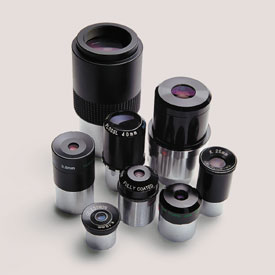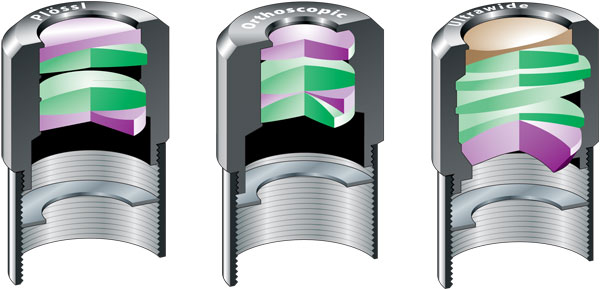How many times have you bought an eyepiece for your telescope? Chances are you're still using the budget models supplied with your telescope. What isn't readily appreciated by a great deal of observers is just how important good eyepieces are to scope performance.

Sky & Telescope / Craig Michael Utter
An instrument can possess the finest objective lens or mirror, but the exquisite detail at its focus will not be faithfully conveyed to the eye or camera unless an eyepiece of equal quality is used. It may seem like a small link in the chain, but it can make or break the optical system. When a cheap eyepiece is replaced with a quality one, observers are often astounded, to the extent that they feel as if they have a new telescope — and in a very real sense they do. This telescope eyepiece guide is meant to help guide you to finding what you most need.
What Type of Telescope Eyepiece Should You Buy?
What sort of telescope eyepiece, then, should you use? A casual inspection of most publications advertising optical accessories will reveal a plethora of types — almost as many varieties as telescopes, it seems! Choosing the right one for you depends on several factors: the objects you wish to observe; how tolerant you are of optical imperfections; whether you want narrow or wide fields of view; whether or not you wear glasses; and (as always) how much you are prepared to spend. But before we examine specific eyepiece designs, here's a quick primer on the basics.
Magnification
Every telescope has a stated focal length, which is effectively the distance from the primary lens or mirror to the point at which it forms an image of a very distant object. This is a figure that you'll usually see printed or engraved near the eyepiece focuser and usually lies in the range of 400- to 3000-mm, depending on the aperture and type of telescope. Eyepieces have focal lengths, too — 25- or 10-mm, for example, and thus their own magnification.
To calculate the magnification, simply divide the focal length of the scope by that of the eyepiece. A 2000-mm focal length scope used with a 25-mm eyepiece will therefore deliver 2000/25 = 80 power (or 80x). Note that the same eyepiece used with a different focal length scope will give different powers. Here's a simple magnification calculator:
But there's also a minimum magnification beyond which light emerging from the telescope eyepiece will spill around the dilated pupil of the eye and be wasted. The largest-focal-length eyepiece you can use with your telescope is easy to calculate: multiply the focal ratio (the focal length of your scope divided by its aperture) by 7.
For example, your Newtonian scope is f/5: the largest-focal-length eyepiece you should use is 35 mm. (Note: there is no harm in using a lower-power eyepiece — you will still be seeing the brightest possible view — but you will not be using all the light-collecting ability of the telescope's objective.)
Telescope Eyepiece Sizes
There is one specification that is very important when you are considering an alternative eyepiece for your telescope — its physical size. The vast majority available today have chromed barrels with a diameter of 1¼ inches (31.7 millimeters), that slide into the push-fit focusers of most telescopes.
You will also encounter designs intended to show you wide views with barrels 2 inches (50.8 mm) in diameter. Occasionally you will come across scopes (typically older ones) that accommodate 0.965 inch (24.5 mm) barrels.
Field of View
Aside from the focal length, each eyepiece has an apparent field of view, measured in degrees (°). This tells you the width of sky, in angular terms, that is presented to your eye — eyepieces with larger apparent fields take in greater gulps of sky than smaller ones. Simpler eyepiece designs tend to have apparent fields of about 45°; widefield designs may be 60° or more.
What is sometimes more important to the user is the true field of view, which is obtained by dividing the apparent field by the magnification the eyepiece delivers. For example, consider a 10 mm-focal-length eyepiece of 50° apparent field in combination with a scope of 1,000 mm focal length. The magnification will be 100x (that is, 1,000/10) and the true field will be 50°/100x, or 0.5° — so the full Moon would just nestle within the field of view. Here's a general purpose true field calculator:
Eyepiece Types
Some names, like Ultrawide, give a clue to an eyepiece's principal characteristics. Others have classic names like Kellner, Orthoscopic, Plössl, and Erfle, or more specific modern variants like Nagler and Lanthanum. Optical aberrations (deviations from the "ideal" form) are better corrected in some designs than others, but like everything in life, the higher the price, the better the quality.
Even so, eyepieces with desirable characteristics still can be obtained at reasonable cost once you know what to look for. At the budget end of the market, three-element (meaning they have three lenses inside) eyepieces labeled Kellner or "MA" (modified achromat) can turn in a good performance with scopes of long focal ratio, such as Schmidt-Cassegrains and traditional refractors. They do not work well with telescopes of short focal ratio.

Gregg Dinderman / S&T
For optically "fast" Newtonians and the like, better results will be obtained with four-element designs, such as the slightly out-of-fashion but otherwise desirable Orthoscopic, or the ubiquitous Plössl. The latter is a good all-rounder, particularly when antireflection multicoated. A Plössl can deliver well-corrected, wide fields of view with good eye relief — meaning the eye can be positioned at a comfortable distance behind the rear lens and still see the whole field of view.
It is worth pointing out that observers who wear glasses to correct for simple long- or short-sightedness (no astigmatism) don't need to use them at the telescope; a twist of the focuser will remedy that.
High-power lunar and planetary viewing entails the use of short-focal-length eyepieces, which can be a problem owing to the small eye relief of conventional designs. This has spawned the development of six- to eight-element designs that combine comfortable eye relief and wide apparent fields across the focal-length range. They may feature exotic rare-earth glass elements to reduce optical aberrations still further.
Many regard these Lanthanum and Ultrawide designs as the pinnacle of eyepiece evolution (and rightly so), but for many people the price will be a barrier — and their physical size and weight may be an issue for delicately balanced small scopes.
Barlow Lenses
While the Barlow is not strictly an eyepiece, our discussion would not be complete without mentioning this enormously valuable accessory. A Barlow is inserted into the telescope's focuser before the eyepiece and instantly doubles (or triples, in some instances) the magnification. At the expense of a small loss of light, this very useful device can double your eyepiece investment by making each perform at two powers.
If you are contemplating purchasing a Barlow with a set of eyepieces, give some thought to staggering the focal lengths so that they are not simple multiples of one another: a 10 mm eyepiece is largely redundant if you use a 20 mm and a Barlow. Look for "achromatic" and "multi-coated" specifications when shopping around.
 0
0









Comments
You must be logged in to post a comment.